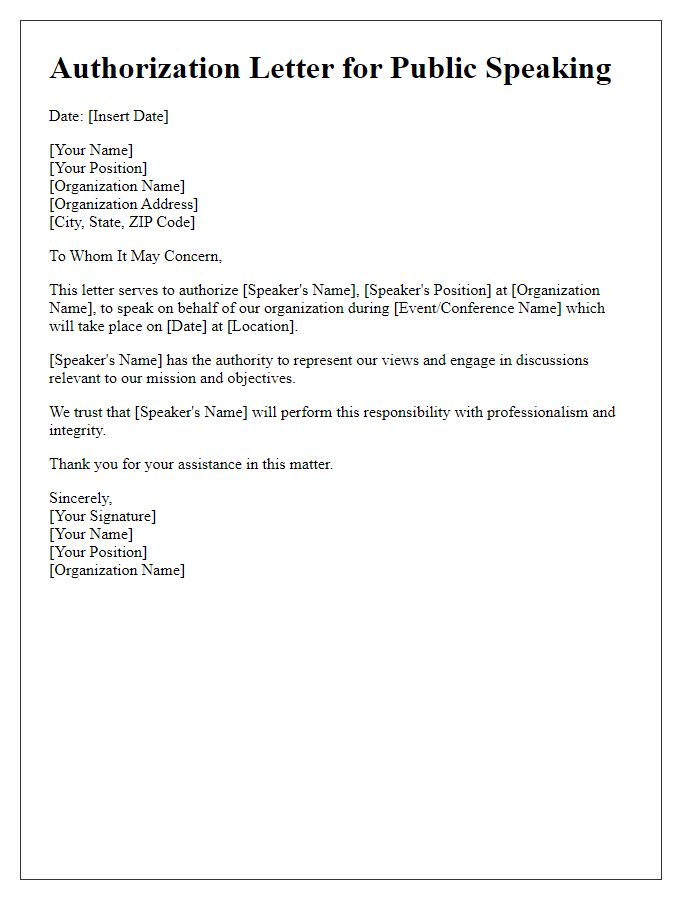Are you looking to represent someone in a public speaking engagement, but unsure about the proper steps to take? Crafting a letter of authorization is essential for securing permission and ensuring a smooth process. This guide will walk you through the necessary components to include, making the experience easier for both you and the speaker. Ready to dive deeper into creating an effective authorization letter? Let's explore!

Contact Information of Authorizer
Public speaking events often require formal representation authorization. The contact information of the authorizer can be crucial for establishing credibility and ensuring smooth communication. An effective authorization document should include full name of the authorizer, professional title, organization name, organization address, phone number, and official email address. Additionally, it may specify the event details such as date, location, and purpose, providing context for the authority granted. This information helps in identifying the authorizer and facilitates any follow-up inquiries regarding representation.
Full Details of Authorized Representative
Authorizing a representative for public speaking engagements involves granting permission for an individual to speak on behalf of an organization or individual. This authorization typically includes the representative's full name, contact details, and any relevant credentials or experience. Organizations may seek to empower someone to represent them at important events like conferences, seminars, or community outreach programs. A well-defined authorization letter ensures that the representative can effectively communicate the values and objectives of the organization, enhancing its visibility and credibility at public forums. It is crucial to specify the duration of authorization and any limitations on the representative's powers to act on behalf of the organization.
Specific Scope and Duration of Authorization
Public speaking representation authorization permits designated individuals to speak on behalf of an organization or group at events. Specific scope of authorization details the topics, themes, and objectives the representative can address, ensuring alignment with organizational values and messaging. Duration of authorization defines the time period during which the individual is authorized to represent the organization, often tied to specific events, such as conferences, seminars, or community outreach programs. This document provides clarity and protects the integrity of the organization's voice in public forums, fostering effective communication and outreach strategies. Legal terms often included clarify responsibilities and liabilities, reinforcing the importance of clear and defined representation.
Signature and Date from Authorizer
Public speaking representation authorization grants permission for a designated individual to speak on behalf of another party during formal events, such as conferences or seminars. This authorization typically requires the author's name, signature, and date to validate the agreement. The event location, date, and specific topics to be addressed enhance clarity and ensure that representation aligns with the author's intentions. Including contact information for both the authorizer and the representative ensures effective communication and confirmation of the representation agreement. Proper documentation is crucial for maintaining professionalism and accountability in public speaking engagements.
Conditions and Limitations of Representation
Public speaking events often require clear guidelines regarding representation and authority. Authorization for public representation typically includes specific conditions and limitations aimed at ensuring the integrity of the message delivered. Conditions may outline the duration of representation, the target audience, and the subject matter to be discussed, ensuring alignment with the organization's mission. Limitations may address the scope of authority, such as prohibiting alterations to the original messaging or brand image during the representation. Observing these guidelines fosters cohesive communication and prevents misrepresentation, ultimately supporting a unified public image during events held at venues like conference centers in major cities or community forums.
Letter Template For Public Speaking Representation Authorization Samples
Letter template of Public Speaking Authorization for Event Participation

Letter template of Authorization for Public Speaking on Behalf of an Organization

Letter template of Representation Letter for Public Speaking Opportunities











Comments